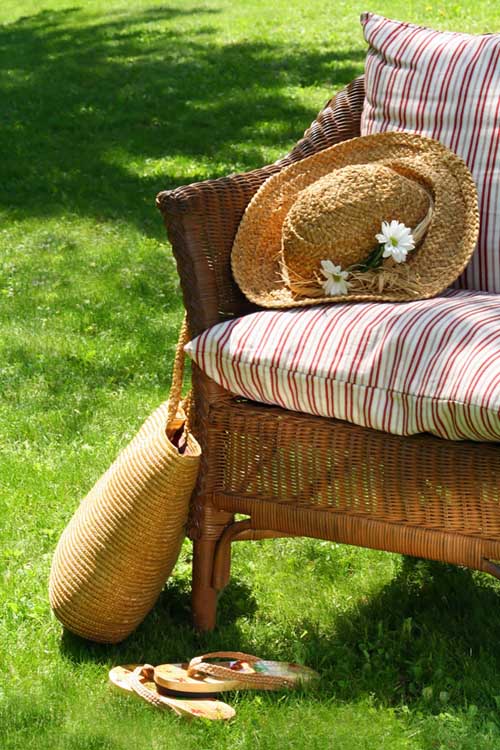Varnishing, painting, and waterproofing are techniques that can prevent this material from becoming damaged by weather exposure. There are plenty of items made of wicker that can be placed in and around the garden to provide a nice decorative element to your landscape.
Items to Consider
Wicker chairs will make an excellent addition to your garden while also creating an extra outdoor living space. Perhaps you have one or two old woven chairs setting around that could use fixing up. Simply apply a coat of paint for weatherization purposes (it is even possible to use spray paint on the fibers), then add a coat of varnish for even more protection, and your chairs will be ready to go. The painting and varnishing of the pieces will help improve the overall aesthetic of your garden space. Of course there are many types and styles of wicker baskets to use in your garden. Baskets can be great for potting various plants, or they can be hung overhead. Keep in mind that buying plastic-lined baskets will be more durable and better for garden use. Some baskets are designed mainly for holding and carrying gardening tools with many different designs to choose from: trays, caddies, baskets in square and oval shapes, also lidded and unlidded ones with stylish arching handles. Wicker trunks are also available for purchase. These trunks are highly durable and resistant to extreme weather. They have rust-proof hardware and provide large amounts of storage space for any gardening tools or other items you need to store while keeping them close at hand. If you’d like to get especially fancy, you can purchase a multi-piece patio set for inclusion near your garden (they also have chaise lounges available too, although those would probably be more appropriate for inside the home!).
Where Wicker Comes From
Wicker is made from fibers of plants and “climbing palms” such as rattan, reed, and bamboo. It is also produced from a man-made product called “paper fibre rush,” which was invented in 1904. The frames of various pieces are usually constructed from sturdier materials, then fibers are woven over the frame. The qualities that make this material so attractive is that it’s extremely light-weight, yet very sturdy. This furniture construction technique has been around since ancient times, when the ancient Egyptians made and used wicker furniture! When shopping second hand, be aware of any pieces that could be antiques and do not use those in your garden since collectors may pay high prices for them.
Cleaning and Maintenance
Wicker is also easy to clean after it picks up dirt and debris from being outdoors for long periods of time. But for proper care, it is best to keep any unprotected pieces off of any grass (because of dew) and any other things that can be sources of continuous moisture.
Various leg cappings can be put onto chairs for protection, but it’s always a good idea to paint and varnish your furniture for outdoor use. Too much water will ruin unprotected wicker, making it limp and saggy – although it can tolerate a small amount of wetness without becoming unusable. If it does get excessively wet, it will usually revert back to its shape as it dries. But it is important that you do not move or bend it if the fibers have been exposed to a high amount of moisture, because they can be remolded easily, changing their shape and staying in the new position permanently. Cleaning this fiber based material is simple. Simply use a brush with medium-sized bristles to remove any dirt buildup. A vegetable brush usually works great for this. A vacuum cleaner with a soft bristle attachment can also be handy. You can use a mild soap or detergent and a damp cloth for cleaning the really dirty spots. And if those suggestions are not effective enough for stubborn areas, a mild furniture cleaner can be used. A mixture of bleach and water can also be good for removing any mildew or mold. Overall, there are infinitely many decorative possibilities with this material. Get stylish by adding plenty of wicker pieces to your garden today so that it never falls into the “humdrum” category. © Ask the Experts, LLC. ALL RIGHTS RESERVED. See our TOS for more details. Uncredited photos: Shutterstock.
